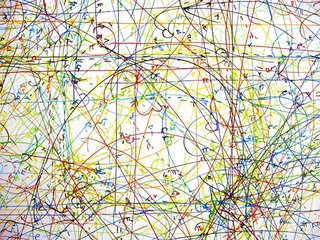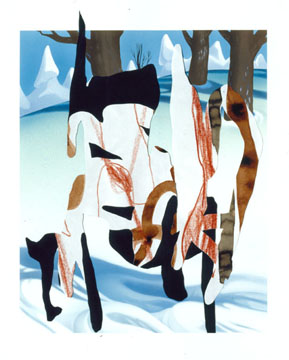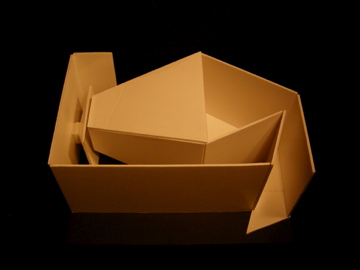Docent Notes
1.8.2007
Harry Philbrick, Richard Klein
Bill Schott
Kysa Johnson, Elana Herzog & Michael Schumacher
Beginning March 11, 2007
Elana Herzog & Michael Schumacher: W (E) AVE
Kysa Johnson: Blow Ups—Spores, Pollen, and Pollutants

Kysa Johnson’s artworks combine science and art in order to allow a viewer to see the unseen. Beginning March 11, 2007, she will exhibit several framed works at The Aldrich Museum, in addition to a large-scale site-specific wall drawing. This wall drawing will be seen on a prominent wall in the Leir Atrium. This wall is immediately to the left of the viewers as they enter the building. The wall is 15’ x 15’ in size and has been covered in a matte black paint. Kysa’s drawing will consist of a series of enlarged microscopic images rendered in white chalk. Looking at some of Kysa’s previous work, one could describe her style of drawing as delicate and repetitive. This wall drawing will integrate drawings of spores that float through the water and air—the type of image one can only see if analyzed underneath a microscope. The sample of spores will be taken from the Hudson River. The pollutants, such as benzene, ethane, hexane, and methane, will be rendered as a traditional chalk drawing.

In many ways, the works reflect or contrast the ideas of a heightened landscape or an industrial landscape series. The microscopic images’ execution visually reminds us of pointillism. It is both abstract and representational. Abstract in that the images are unfamiliar; representational in that they are accurate renderings of what is visible to the eye when aided by a microscope or a similar device.
Since the work will feature white marks on a black background, there are several connections to make to this method of working. The chalk drawings of the classroom and the work of teachers around the world may be brought to mind, some may think of the paintings of the Hudson River School, or the chalk drawings of Joseph Beuys, Carolina Pedraza, or Cy Twombly. A viewer could also connect this work to the methods of artisans in the Renaissance, who would find disease and toxins visually appealing topics to render. All of these art-historical ideas can be used to enhance the viewers’ understanding of this work, which considers the blackboard as an art object and brings to our attention the sub-atomic-particle decay pattern as aesthetic.
Ultimately, Kysa values her interest in nature and her fascination with it. What is a pollutant? She is taking what is around us and depicting it. This work reminds us again about how the Internet has influenced our understanding of reality. In a matter of minutes one may gain access to imagery that can then be plugged into an artwork. An artist dealing with science has information at her/his fingertips.

How does the brain manage this type of information? Consider how the Internet as a system influences human thought processes. This enhanced level of technology allows for reinterpretation and indirect mismatch and misplacement. Consider, if you will, the watercolor and pen and ink drawings of Steve Mumford. His work is very different from a photograph. What is this difference? Both are equally valid and good ways to document reality. However the techniques of editing and reporting information are very different.
It is akin to a visit to The Aldrich Museum. If you come during one series you see a snapshot of the institution. Whereas, if you come on an ongoing basis, you become privy to the institution’s ever-changing emphasis on contemporary artwork. The diversification of work over time is the only dominant theme.
Richard Klein on Elana Herzog and Michael Schumacher
W (E)AVE is a collaboration between visual artist Elana Herzog and audio artist Michael Schumacher. Both are new to collaborative works and are excited to see how this project will unfold. They fell into a conversation sometime in 2006 and became interested in each other’s practice. Both acknowledged a degree of randomness within their technical process and determined that they should collaborate.
Michael is a musician, classically trained at Julliard. He has in the past created room pieces and designs for installations dispersed through a series of spaces. He makes installations where sound comes from multiple points, angled in different directions. The audio typically includes sounds gleaned by listening to the world, sounds that are all around us..
Spatial relationships for sound are intriguing. Consider how with sound, as opposed to sight, we can hear around corners. Activating space with sound is an art in and of itself. Sound makes a viewer more aware and ultimately active versus passive. While most cases of listening are passive, active listening requires sounds that grab and hold our attention. This can be done in a variety of ways. Initially, the sound must get our attention—for instance, an unusual or abrupt sound can surprise and pique a listener’s interest, thus activating a different consciousness and awareness. This practice of activating viewer awareness is central to making art. Traditionally, museums have focused on visual artwork. By exhibiting sound artists in a contemporary art museum the viewers are encouraged to expand their concept of art.
Michael Schumacher had a Berlin residency in a gallery space where he composed a sound performance, developing something radically different. As opposed to creating a sound work with a finite beginning and end, his work was a constant performance. It has 57 self-generating voices and it generates new sounds by using a computer program. The computer creates a composition within a parameter of possible permutations and the results are always different. This was turned into a permanent sound piece for (is this the artist John Simon, Jr., who has exhibited at The Aldrich? If so, let’s say so) John Simon, who lives at the top of the Chelsea Hotel. In John Simon’s apartment, this work repeats every day, 24 hours a day. It is somewhat experimental and 40-50% are found sounds. At night the volume lowers, but during the daytime the apartment is filled with ambient sound.

Elana Herzog staples found fabric and textiles to the wall. Once it is fastened, she takes the material and removes sections from the piece by tearing. Most of the work is done beforehand in the studio, where the artist staples the fabric to sheetrock. Then she installs the sheetrock with the stapled fabric into the exhibition space. Her materials include plywood, sheetrock, pins, staples, and patterned fabric. Her process is somewhat aggressive, as she uses a contractor’s pneumatic staple gun to keep the fabric attached to plywood. The act of tearing away the unstapled components of a bedspread or rug design is also physical. Weave and pattern are essential to this work, as the elements and flower motifs within the design suggest where to staple. When finished, the fabric looks as if it is either subsumed or emerging from the wall. There is a visual coming and/or going. Her work grows out of feminist art of the 1960s and 70s and it incorporates high and low aspects of art craft by turning carpets into painting.
The collaboration will incorporate synthesized sound, traditional instrumentation, piano, and violin. The audio will be processed to a point where it is less immediate, with the intent that it will mimic the new wall construction. Metaphorically, the sound’s primary function is to envelop us and cause us to embrace the space in a new way.







